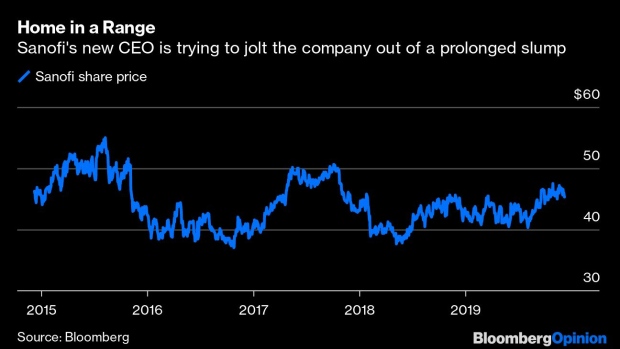Dec 9, 2019
Flagging French Drug Giant Tries a Familiar Remedy
, Bloomberg News

(Bloomberg Opinion) -- Sanofi CEO Paul Hudson didn’t inherit an easy job when he took over the French pharma giant in September. The company’s shares have been in the doldrums for years, weighed down by a sagging diabetes business and a weak pipeline of new drugs.
The former Novartis AG executive kicked off his turnaround effort in earnest Monday by announcing the acquisition of cancer startup Synthorx Inc. for $2.5 billion and releasing a new strategic plan for the drugmaker. Under Hudson, Sanofi plans to halt investment in heart and diabetes research, doubling down on other areas including cancer and rare diseases. The company’s consumer unit will become a stand-alone business, which raises the specter of a possible future sale.
All of the moves make some sense and are in line with what other large drugmakers, including his prior employer, have tried in recent years. The key to success for Sanofi will be execution, and there are pitfalls aplenty.
One of the most significant changes at Sanofi is its move away from once-core diabetes and heart medicines. Hudson says he sees more valuable opportunities elsewhere, and he could be right; pricing pressure has made those areas increasingly competitive. Sanofi’s new areas of focus may offer more growth potential and higher prices, which will be crucial if the company is going to hit Hudson’s ambitious new margin-improvement goals.
Sanofi is arriving somewhat late to a shift that many of its rivals have been embracing for years, however. It has a lot of catch-up to do, and it isn’t starting with the industry’s healthiest balance sheet. A big chunk of its available cash will go to Synthorx, which is a particularly risky cornerstone for a new-look Sanofi.
It makes sense that Sanofi might be interested in Synthorx’s lead product, THOR-707. That medicine and others in Synthorx’s pipeline could combine with Sanofi’s immune-boosting cancer drug Libtayo. “Could” is doing a lot of work there. Sanofi just paid one of the biggest biotech premiums of the past few years for a company that has generated little proof that its approach works. Hudson will have a hard time sufficiently stocking his pipeline if he’s paying exorbitant prices for very early-stage drugs.
Selling some part of Sanofi’s multi-billion-dollar stake in Regeneron could help finance further deals, as could divesting the firm’s consumer unit. We’ll find out more about Sanofi’s over-the-counter intentions at its capital markets day Tuesday. Its preference for higher-margin products and separation of the unit certainly suggests that a sale is a possibility.
Slimming down worked out well for Novartis, which has reaped billions in proceeds and a higher multiple by getting rid of consumer and eye-drug units. That doesn’t mean Sanofi will have the same experience. The 2018 sale of Novartis’s consumer arm was the result of a long-running saga that started five years earlier with a complicated asset swap with GlaxoSmithKline PLC under which it paid out more money than it got. Pfizer Inc.’s long-running effort to get rid of its over-the-counter arm ended with, you’ll never guess, a proceed-free joint-venture with GSK. The market hasn’t received Pfizer’s efforts especially kindly.
It’s a positive sign that Hudson is taking action and putting his stamp on the company. But just because the strategic road he’s taking is well-trodden doesn't mean it will be easy.
To contact the author of this story: Max Nisen at mnisen@bloomberg.net
To contact the editor responsible for this story: Beth Williams at bewilliams@bloomberg.net
This column does not necessarily reflect the opinion of the editorial board or Bloomberg LP and its owners.
Max Nisen is a Bloomberg Opinion columnist covering biotech, pharma and health care. He previously wrote about management and corporate strategy for Quartz and Business Insider.
©2019 Bloomberg L.P.